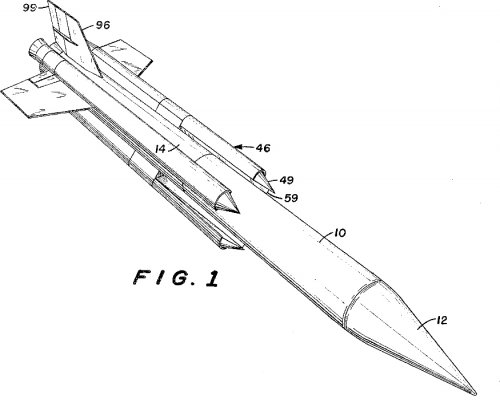History of Ramjet and Scramjet Propulsion Development
for U.S. Navy Missiles
This appears to be the patent for the missile. The attached image is extracted from it. The fuel used is 50% boron. Would this be a significant contributing reason as to why the missile was not funded for further development and flight testing? If my memory serves me, boron was highly carcinogenic and made for a very smoky exhaust in the High Energy Fuels program for the Valkyrie.
Also, I do not understand why the extended range version of the missile would be 4 inches shorter (though with a booster 148 inches long) and weigh almost 4700 pounds (3.6 times) more for only twice the range. Granted, I'm no engineering person, so there's probably some blatantly obvious reason that I simply don't know of.
for U.S. Navy Missiles
In 1965, the Navy initiated an advanced development program to determine the performance of air-ducted rocket propelled missiles. Thus began the Augmented Thómst Propulsion program conducted at APL with its two subcontractors, Martin Marietta/Denver and the Atlantic Research Corp. The objectives of the Augmented Thrust Propulsion program were to develop the propulsion (APL), fuels (Atlantic Research Corp.), and missile configuration (Martin Marietta/Denver) for an antiair alternative to the then-existing SM (Terrier, SM-I) and Talos missile systems. The emerging integral rocket ramjet (IRR) technology was also to be investigated. The propulsion and solid- fuel technology programs were successfully carried out in a collaborative effort between APL and the Atlantic Research Corp. High ramjet combustion efficiency (up to 90%) with up to 60% boron-loaded solid fuels was demonstrated, as were high-efficiency axisymmetric and half-axisymmetric conical inlet designs. Two-dimensional flush-mounted (during boost), pop-out inlets were also demonstrated to perform adequately.
Two basic tactical missile configurations that also evolved were designated Thrust Augmented Rocket Surface-to-Air Missiles (TARSAMs). Both configurations were 13.5 in. in diameter and were designed to cruise at Mach 3.8 after boost to Mach 2.7. The medium-range version had a predicted powered range on the order of 80 nmi, and the extended-range configuration (TARSAM-ER) had a powered range of around 160 nmi. This program was concluded as planned in 1971, but the proposed follow-on flight tests were not funded.
This appears to be the patent for the missile. The attached image is extracted from it. The fuel used is 50% boron. Would this be a significant contributing reason as to why the missile was not funded for further development and flight testing? If my memory serves me, boron was highly carcinogenic and made for a very smoky exhaust in the High Energy Fuels program for the Valkyrie.
The propellant grain, in one planned embodiment, is composed of 50% boron, 4% aluminum, 25% ammonium perchlorate, 15% binder and 6% nBF additive. The propellant grain surface is conical to accommodate the burn rate characteristics of the wire
Also, I do not understand why the extended range version of the missile would be 4 inches shorter (though with a booster 148 inches long) and weigh almost 4700 pounds (3.6 times) more for only twice the range. Granted, I'm no engineering person, so there's probably some blatantly obvious reason that I simply don't know of.

